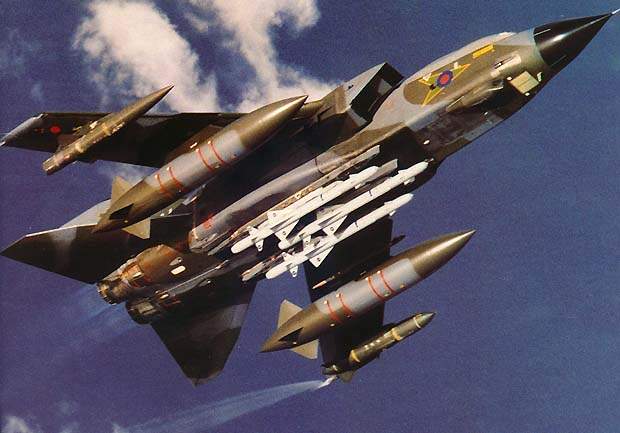| Country of origin |
Italy, United Kingdom, West Germany |
| Entered service |
1979 |
| Crew |
2 |
| Dimensions and weight |
| Length |
16.72 m |
| Wing span |
13.91 m spread, 8.6 m swept |
| Height |
5.95 m |
| Weight (empty) |
13.8 t |
| Weight (maximum take off) |
27.9 t |
| Engines and performance |
| Engines |
2 x Turbo-Union RB.199 Mk.103 turbofans |
| Traction (dry / with afterburning) |
2 x 38.48 / 71.50 kN |
| Service ceiling |
15.2 km |
| Maximum speed |
2 236 km/h |
| Range |
1 390 km |
| Ferry range (with drop tanks) |
3 900 ~ 4 300 km |
| Armament |
| Cannon |
2 x 27 mm IWKA-Mauser cannon |
| Missiles |
Storm Shadow or Taurus air-launched cruise missiles, AGM-88 HARM anti-radar missiles, Brimstone anti-tank guided missiles |
| Bombs |
454 kg free-fall bombs, CPU-123/B Paveway II and GBU-28 Paveway III laser-guided bombs |
|
Development of the Tornado began in 1968. This was a multi-national programme of the United Kingdom, West Germany and Italy. Prototype made its first flight in 1974. Service deliveries began in 1979. Production ceased in 1998. The Tornado Interdictor Strike aircraft (or IDS) is currently in service with all three nations that developed it. Saudi Arabia was the only export customer. Nearly 1 000 of these aircraft were produced. The Tornado IDS remains one of Europe’s most important warplane. The various different attack, reconnaissance and defense suppression versions have played major roles during recent military operations.
The RAF’s current force comprises eight frontline units that are primarily assigned the conventional long-range interdiction/overland attack role. The also have specialized missions that comprise maritime attack (GR.1B), defense suppression and reconnaissance (GR.1A).
Since 1999 the RAF has received GR.1s upgraded to GR.4 standard with new cockpit displays, compatibility with thermal imaging airborne laser designator pods for autonomous precision guided munitions delivery, integration of night vision goggles with an upgraded forward-looking infra-red and an enhanced self-defense suite. The reconnaissance-configured GR.1As are similarly being upgraded as GR.4As.
British Panavia Tornado aircraft can carry Storm Shadow stealthy cruise missiles. These have a range of 550-560 km and are used to engage command and control centers, communication centers, ammunition storages and other important hostile facilities at standoff ranges.
The Luftwaffe has 276 IDS aircraft currently assigned to five wings. The aircraft went through a comprehensive mid-life update similar to the RAF’s GR.4 programme that also added Litening targeting pods and towed radar decoys. New weapons include BLU-109 and GBU-22 Paveway III laser guided bombs, KEPD 350 Taurus tactical cruise missiles and IRIS-T short-range air-to-air missiles for self-defense.
The Marineflieger currently has a wing with around 50 IDS aircraft assigned conventional attack. Depending on the mission these can be armed with Kormoran anti-ship missiles, Taurus stealthy cruise missiles or AGM-88 HARM anti-radar missiles for defense suppression role. These warplanes can also fly reconnaissance missions.
The Italian Air Force has three fighter-bomber IDS groups, one of which is assigned the anti-ship role with Kormoran missiles. Italy converted 16 aircraft to IT ECR standard with dedicated electronic equipment and HARMs for the defense suppression role. These can also carry SCALP-EG / Storm Shadow stealthy cruise missiles.
Saudi Arabia was the only export customer with surviving of 82 aircraft assigned to three units, one of which operates 12 recce-configured Tornados. Recently Saudi Arabia upgraded around 80 aircraft. |

